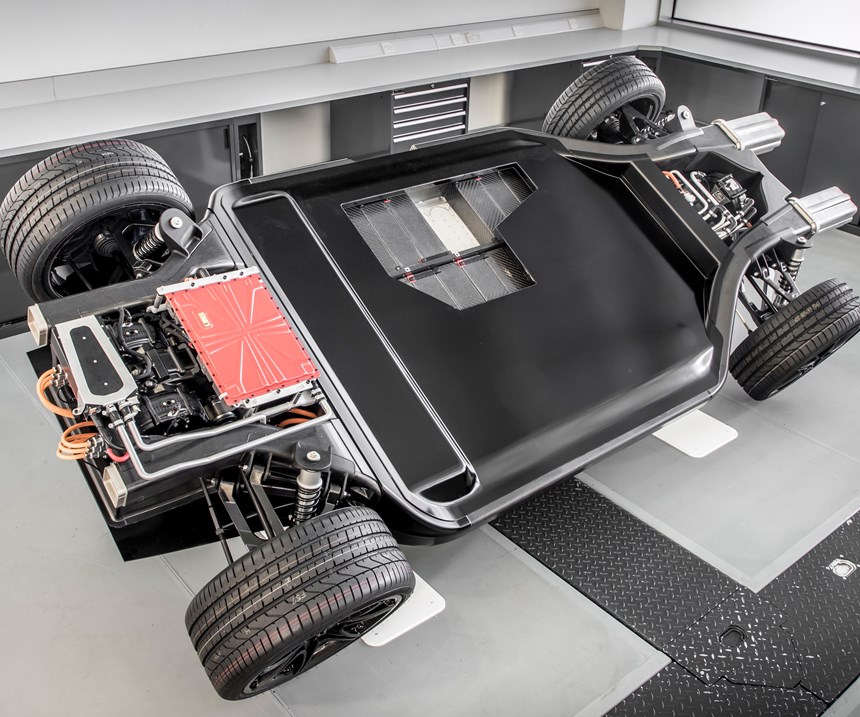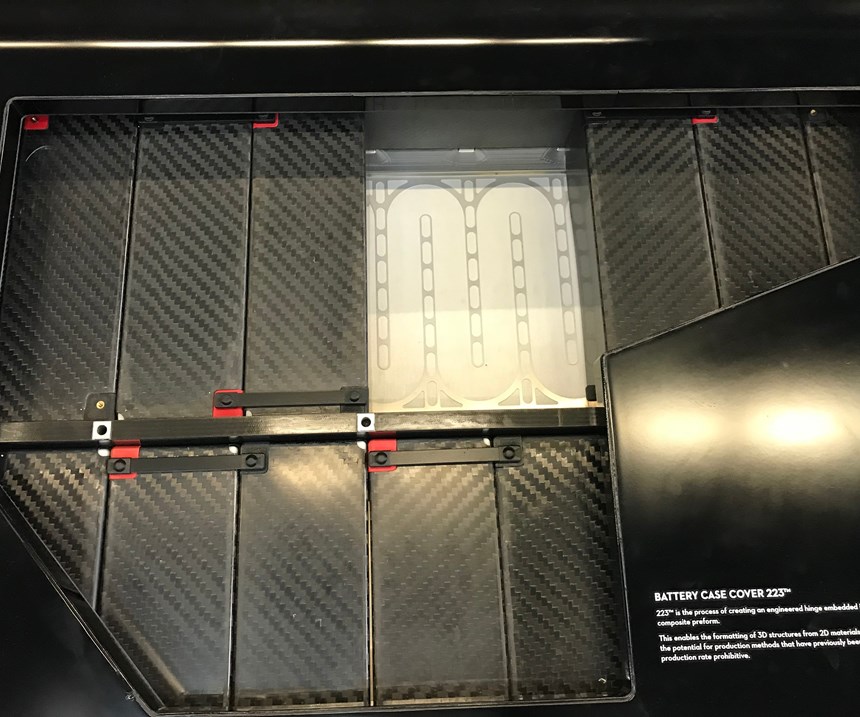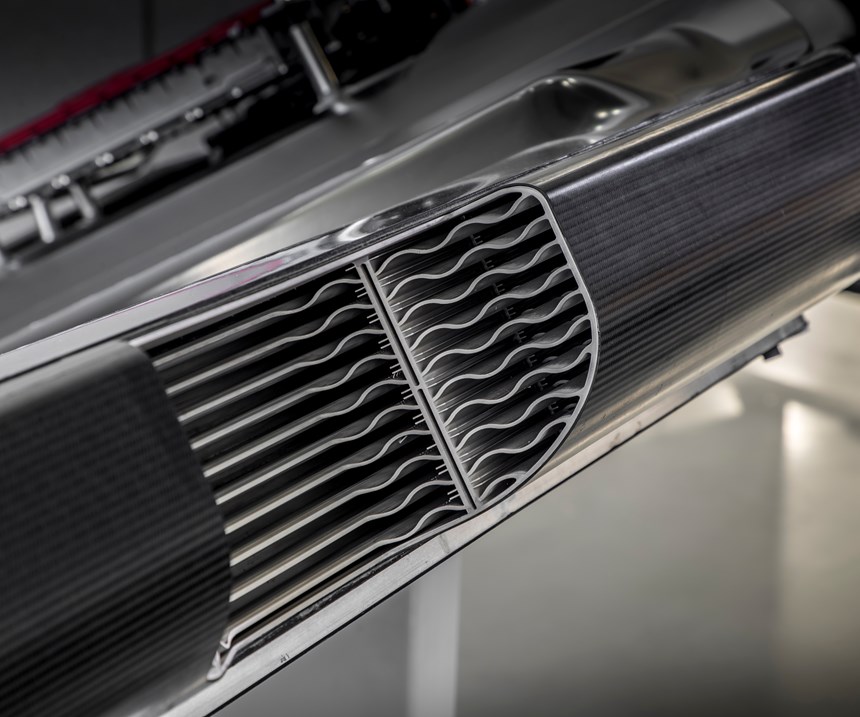Pushing EVs forward
Multifunctional chassis design and novel composites processes enable lighter, longer-range, safer electric vehicles.
Ongoing concerns about the harmful effects of internal combustion engine pollution, combined with advancements in battery technology — costs have dropped 50% in the past three years — are accelerating growth in electric vehicles (EVs). According to the International Energy Agency (IEA, Paris, France), the world EV fleet grew 54% to 3.1 million in 2017 and will hit 125 million by 2030. Bloomberg New Energy Finance predicts that EVs will comprise 55% of all new car sales and 33% of the global fleet by 2040.
With almost every automaker planning expanded EV portfolios (Ford recently announced 40 EVs for its global lineup by 2022), Williams Advanced Engineering (Grove, Oxfordshire, UK) unveiled its FW-EVX platform in 2017. Aimed at manufacturers seeking either a next-generation EV platform or simply specific areas of technology improvement, the FW-EVX purely battery EV (BEV) is scalable by adding or subtracting battery modules to its nominal 2800-mm wheelbase. BEVs are growing faster than plug-in hybrids (PHEVs), currently commanding 66% of the global EV market and 16 of Ford’s planned models.
The FW-EVX pushes a standard format — central, under-floor battery pack with e-motors for front and/or rear axles — to a new level of performance by making the carbon fiber composite-intensive chassis multifunctional, integrating battery cooling and crash protection into the lightweight structure. This high level of integration creates a virtuous circle of reduced weight and aerodynamic drag, increased battery capacity and extended range, explains Williams Advanced Engineering technical director Paul McNamara.
Performance and pedigree
The drivetrain — chassis with 38 battery modules, twin electric motors in rear and one in front, transmission, differential, electronics, wheels, tires and four wishbone suspensions — weighs 955 kg/2,105 lb. With lightweight bodywork added, Williams projects a BMW M4-sized vehicle would total 1,750 kg/3,858 lb. This platform, with an 80-kW-hr battery, would deliver a New European Driving Cycle (NEDC) range of 552 km/343 miles. NEDC is a lab test used to measure vehicle fuel consumption, emissions and range. In 2017, it was replaced by the Worldwide Harmonised Light Vehicle Test Procedure (WLTP), which uses real driving data gathered worldwide vs. a theoretical driving profile. This should make it more comparable to the Environmental Protection Agency (EPA) test used in the US.
Out of 24 BEVs ranked by InsideEVs, only the Tesla Model X P100D and Model S 75D come close in performance, with a battery capacity of 75 and 100 kWh respectively, an NEDC range of 336 and 304 miles respectively, but a weight that is greater by more than 900 lb/408 kg and 1,500 lb/680 kg respectively. The Tesla Model 3 Long Range matches the FW-EVX across the board, while the number one selling Nissan Leaf offers a 235-mile NEDC range with a 40-kW-hr battery and 425 lb/193 kg less weight. (Note that Williams designed the Nissan Bladeglider EV.) However, nothing matches the FW-EVX’s peak power of 480 kW. The closest showings, at 150 kW, are the 2018 Chevy Bolt (323-mi NEDC range with 60-kW-hr battery) and the 2019 Hyundai Kona (258-mile range with 64-kW-hr battery).
The performance of the FW-EVX also exceeds new, tougher standards in China, forecast as the largest market for EVs. To receive government incentives, long-range BEVs must have a range >400 km/249 miles and and energy density of 105 Wh/kg. The FW-EVX has a 552-km/ 343-mile range and more than twice the required energy density at 235 W-hr/kg.
This, perhaps, should be expected. Williams Advanced Engineering is, after all, the technology and engineering services sibling of the renowned Formula 1 team started by Sir Frank Williams (the FW in FW-EVX). Created in 2010, the Williams Advanced Engineering division opened a dedicated new facility in 2014 and now has more than 250 employees and 80 completed projects under its belt, with 40 underway.
Williams’ experience in EV technology is extensive. It has developed world-leading expertise in both flywheel and kinetic energy recovery systems (KERS) for automotive, public transport and energy applications. As the sole supplier for the ABB FIA Formula E Championship — the world’s first fully-electric international single-seater street racing series — Williams has also developed high-power-density batteries and electric motors where high-performance, endurance and predictability are non-negotiable.
The equivalent of more than 1,100 Formula E cars have traveled 240,000 miles on Williams batteries since the first race in 2014. A collision during that race also demonstrated the company’s commitment to the highest safety performance. Other notable developments include a high-performance battery for VW Audi, and its leadership of the H1PERBAT consortium, chosen by the UK government to develop a hybrid battery that will deliver higher power using fewer cells that last longer and charge more quickly than today’s technology. In fact, Williams Advanced Engineering announced in September that it will form a joint venture with Unipart Manufacturing Group (Cowley, Oxford, UK) called Hyperbat Ltd. It will open the UK’s largest, independent battery manufacturing facility at Unipart’s Coventry site in early 2019. The launch customer will be the limited production Aston Martin Rapide E.
As Williams has developed this range of EV technologies, it has also developed the trademarked and patent-pending 223 and RACETRAK composite processing technologies. Aimed at high-volume, low-cost automotive applications, these solutions were created in response to the challenge of how to maximize EV performance and efficiency. However, due to Williams’ innovations in the fast processing of lightweight, carbon fiber reinforced plastic (CFRP) structures, they are attracting interest from aerospace and wind energy companies, as well.
Integrating systems into structure
F1 racecars are exemplars of streamlined efficiency — everything is designed to work together. Williams brings that ideal into the FW-EVX through a series of utilitarian yet elegant integrations.
The core of the FW-EVX structure is its 250-mm-thick “skateboard” monocoque, which stores the battery modules between two hollow, load-bearing, CFRP side rails (side sills). These rails also channel air from crush cans — that double as air intakes — at the front of the car through internal aluminum radiators to cool the batteries. This eliminates conventional radiators up front, minimizing the entire front structure of the car, as well as the aerodynamic drag of heat exchangers. The aluminum-finned radiators also work as controlled crush zones around the batteries, increasing impact protection.
The 38 battery modules located within the monocoque provide not only the EV’s power but also structure. Each 136-mm-wide battery module contains 10 pouch-type lithium ion batteries (think thin, as for a laptop) from LG Chem (Seoul, South Korea). Pouches are stacked and protected within a CFRP box. Each of the 38 battery module boxes are made using flat CFRP sheet and the highly automated 223 process. Portions of the sheet for the box faces are cured, leaving flexible uncured hinges in between. These hinges allow the folding of the partially cured sheet into a box, followed by final cure and bonding to produce a rigid enclosure. Each box is an impact-resistant, load-bearing exoskeleton, aiding in crash safety. The boxes are individually located and secured together to provide significant torsional and bending stiffness through the monocoque. This, in turn, handles some of the load that otherwise would be managed by the CFRP side rails, and thus, allows their design to be further lightweighted.
rCF wishbones
The FW-EVX uses CFRP wishbones to cut weight 40% vs. conventional aluminum versions, yet cost is comparable to aluminum forgings thanks to the RACETRAK process. As reported in a May 2017 article by Engineering UK magazine, RACETRAK is based on high-pressure resin transfer molding (HP-RTM) and was developed in collaboration with the National Composites Centre (NCC, Bristol, UK). The FW-EVX wishbone design combines three fiber formats with one resin. Unidirectional material wraps around an anchor point to increase strength with near-zero waste, while recycled carbon fiber (rCF) — up to 80% of the composite part, by weight — in the form of a nonwoven mat, helps to reduce cost and increase sustainability. Both epoxy and polyurethane resin are already in use for high-volume HP-RTM composite suspension parts (see “Fold-to-form CFRP battery boxes, HP-RTM wishbones”). According to Iain Bomphray, Williams Advanced Engineering chief technology specialist for lightweight structures, the rear wishbone was the thickest part ever made in the NCC’s press. The resulting highly efficient CFRP structural control arm can be molded in 90 seconds, with a 5-min total cycle time, including layup.
Flexibility for future development
Though it uses CFRP extensively, the FW-EVX platform was designed to also use aluminum in the monocoque and suspension. The materials and forming technologies selected are optimized and located to meet overall vehicle performance and efficiency goals. The platform was also designed to be flexible. For example, the battery module currently uses LG pouch cells, but can accommodate multiple battery formats. The off-the-shelf powertrain components, chosen for high performance, may also be readily exchanged for manufacturer-specified alternatives.
Meanwhile, Williams is working to further develop and test the FW-EVX platform. “We’ve applied our extensive knowledge in composites and systems to totally rethink how electric vehicles are designed and built,” says Bomphray. “What sets us apart is not just our abilities in design and manufacturing, but getting all of the systems and structures to work together. We’ve been able to reduce aerodynamic drag and weight, as well as complexity, and invest those savings into greater power, safety and vehicle range.”
Related Content
JEC World 2022, Part 1: Highlights in sustainable, digital, industrialized composites
JEC World 2022 offered numerous new developments in composites materials, processes and applications, according to CW senior editor, Ginger Gardiner, most targeting improved sustainability for wider applications.
Read MorePlant tour: ÉireComposites, Galway, Ireland
An in-house testing business and R&D focus has led to innovative materials use and projects in a range of markets, from civil aerospace to renewable energy to marine.
Read MoreMaterials & Processes: Fibers for composites
The structural properties of composite materials are derived primarily from the fiber reinforcement. Fiber types, their manufacture, their uses and the end-market applications in which they find most use are described.
Read MoreForvia brand Faurecia exhibits XL CGH2 tank, cryogenic LH2 storage solution for heavy-duty trucks
Part of its full hydrogen solutions portfolio at IAA Transportation 2022, Faurecia also highlighted sustainable thermoplastic tanks and smart tanks for better safety via structural integrity monitoring.
Read MoreRead Next
From the CW Archives: The tale of the thermoplastic cryotank
In 2006, guest columnist Bob Hartunian related the story of his efforts two decades prior, while at McDonnell Douglas, to develop a thermoplastic composite crytank for hydrogen storage. He learned a lot of lessons.
Read MoreComposites end markets: Energy (2024)
Composites are used widely in oil/gas, wind and other renewable energy applications. Despite market challenges, growth potential and innovation for composites continue.
Read MoreCW’s 2024 Top Shops survey offers new approach to benchmarking
Respondents that complete the survey by April 30, 2024, have the chance to be recognized as an honoree.
Read More




















.jpg;maxWidth=300;quality=90)












